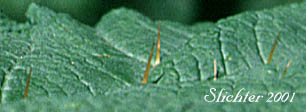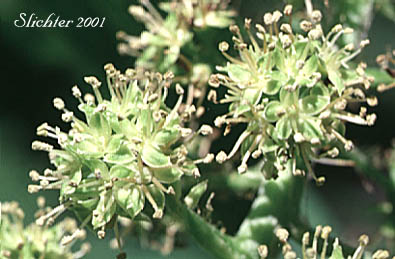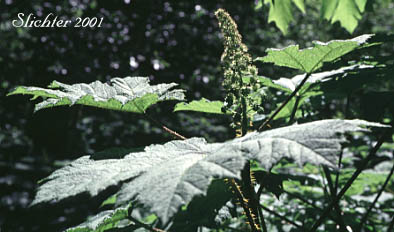
 Characteristics:
Characteristics:
As both its common and species name imply, devil's club is a plant that one does not want to encounter first hand. It is a deciduous shrub with one to several erect stems from 1-7 meters high. The thick stems, petioles and leaf veins are generously covered with sharp yellow spines from 5-10 mm long. Older stems have a gray bark while the younger twigs and buds are reddish brown. The large leaves are simple and palmately lobed, the 7-9 lobes being shallow. The margins of the lobes are doubly serrate. The blades are about 10-35 cm wide and are about as long as the stout petioles. The base of the blade is hear-shaped.
The inflorescence is a terminal panicle or raceme up to 25 cm long. Individual flowers are greenish or white with 5 petals and measure 5-6 mm wide. The petals are long and loosely twisted. The flowers each have 20 stamens. The bright red berries are somewhat flattened and are 5-8 mm long.
Despite the spiny nature of this plant, it can be used as an ornamental shrub. The layered look of the large leaves give the plant a tropical appearance and the berries are showy. The berries are inedible for human consumption but are eaten by bears. The leaves are eaten by slugs. The plant, when planted in dense rows could be used as an effective barrier to prevent livestock or humans from entering the wetland. Native Americans used the berries to repel lice and treat dandruff by rubbing the berries in the hair. The stems and spines were used to make fish hooks and lures. The outer bark of the stems was used as a dye or deodorant.
Devil's club is a riparian plant and may be found along forest streams and in moist soils in the forest.
Devil's club may be found from Alaska south to southern Oregon between the Cascade Mts. and Pacific coast. It may be found eastward through British Columbia and northern Washington to Idaho and Montana and the range extends into Michigan and Ontario.



